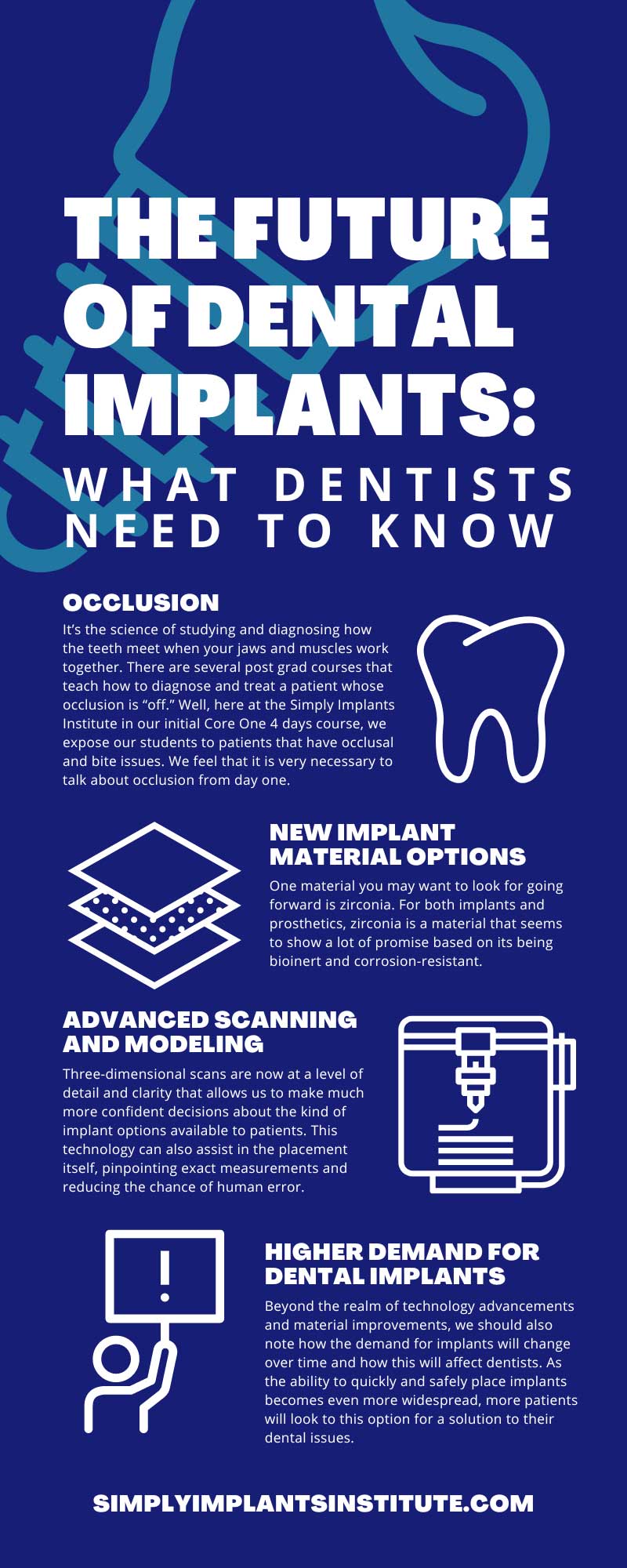The Future of Dental Implants: What Dentists Need To Know

There’s a simple constant in the fields of both medicine and dentistry. That constant is that change is both inevitable and rapid. By the time you finish studying everything you think you should know, new techniques, technology, and theories could replace much of what you learn. As a dental professional, keeping up with this pace of change and adapting to it isn’t just a good idea—it’s absolutely essential. Staying up-to-date ensures that you’re doing your job properly and providing the best options to your patients.
As we believe at the Simply Implants Institute, the next 10 years should be very good years for general dentists that get advanced training in prosthodontics. Meaning? Once general dentists get advanced training in occlusion, aesthetics, sedations, sales, and placing implants, then they can control their own destinies from a business and clinical standpoint. These are topics that we discuss in depth at the Simply Implants Institute.
In terms of placing and restoring dental implants, the pace of change in how we do things has been staggeringly quick. In the last decade alone, there have been numerous improvements in dental implant placement techniques and a large expansion in the number of options patients have. At the faculty practice CR Smiles and the Simply Implants Institute, we also teach and explain what prosthetic options are available to your patients. In general, there are three options that all patients have if they are going to lose their teeth. Yet, every patient is only eligible for 2 out of those 3 options. Do you know what those prosthetic options are? If you don’t, then come to the SII and we will educate and train you on those available options. If we can expect this field to continue changing so quickly, what should we look forward to then? What technologies and techniques on the horizon may become standard practice sooner than we might think? This article will go a little deeper into what dentists need to know about the future of dental implants to keep you in the loop.
Occlusion
It’s the science of studying and diagnosing how the teeth meet when your jaws and muscles work together. There are several post grad courses that teach how to diagnose and treat a patient whose occlusion is “off.” Well, here at the Simply Implants Institute in our initial Core One 4 days course, we expose our students to patients that have occlusal and bite issues. We feel that it is very necessary to talk about occlusion from day one. If you don’t understand the basics of occlusion, you could end up placing implants perfectly that will ultimately fail due to harmful bite forces.
New Implant Material Options
A dental implant is only as reliable as its material. No matter how skilled you might be in placing implants, you don’t have a ton of control over their materials and manufacturing process. Modern dental implant materials are already highly resistant to developing infections or rejection, but there is always room for improvement.
One material you may want to look for going forward is zirconia. For both implants and prosthetics, zirconia is a material that seems to show a lot of promise based on its being bioinert and corrosion-resistant.
Advanced Scanning and Modeling
The process of getting a patient the implant they need isn’t all about the placement itself. The planning and development stages are just as important as getting the implant in place. A useful thing that dentists should know about the future of dental implants is how advanced scanning and modeling technology can make these planning stages much faster.
Three-dimensional scans are now at a level of detail and clarity that allows us to make much more confident decisions about the kind of implant options available to patients. This technology can also assist in the placement itself, pinpointing exact measurements and reducing the chance of human error.
Remember that technology is important. Here at the Simply Implants Institute, we teach you how to safely and accurately place dental implants freehand in a variety of situations. This is very important because sometimes the surgical guides based off this technology could be slightly off.
Reduced Chances of Infection
Infections developing at the implant site are nightmare scenarios that no dentist or patient ever wants to deal with, but they can happen. Through material improvements, better implantation techniques, and other advancements, the number of occurrences of infection has dramatically decreased since implants became an option in the first place.
Infections are still a possibility, though, which is why we’ll likely see more thought put into the implant process to combat them. Some implants now come with anti-microbial substances built into the implants themselves. With time, they slowly release the chemicals to prevent biofilm build-up and reduce the chances of infection. The likelihood that we’ll see more innovations like this in the future is quite high.
Higher Demand for Dental Implants
Beyond the realm of technology advancements and material improvements, we should also note how the demand for implants will change over time and how this will affect dentists. As the ability to quickly and safely place implants becomes even more widespread, more patients will look to this option for a solution to their dental issues.

